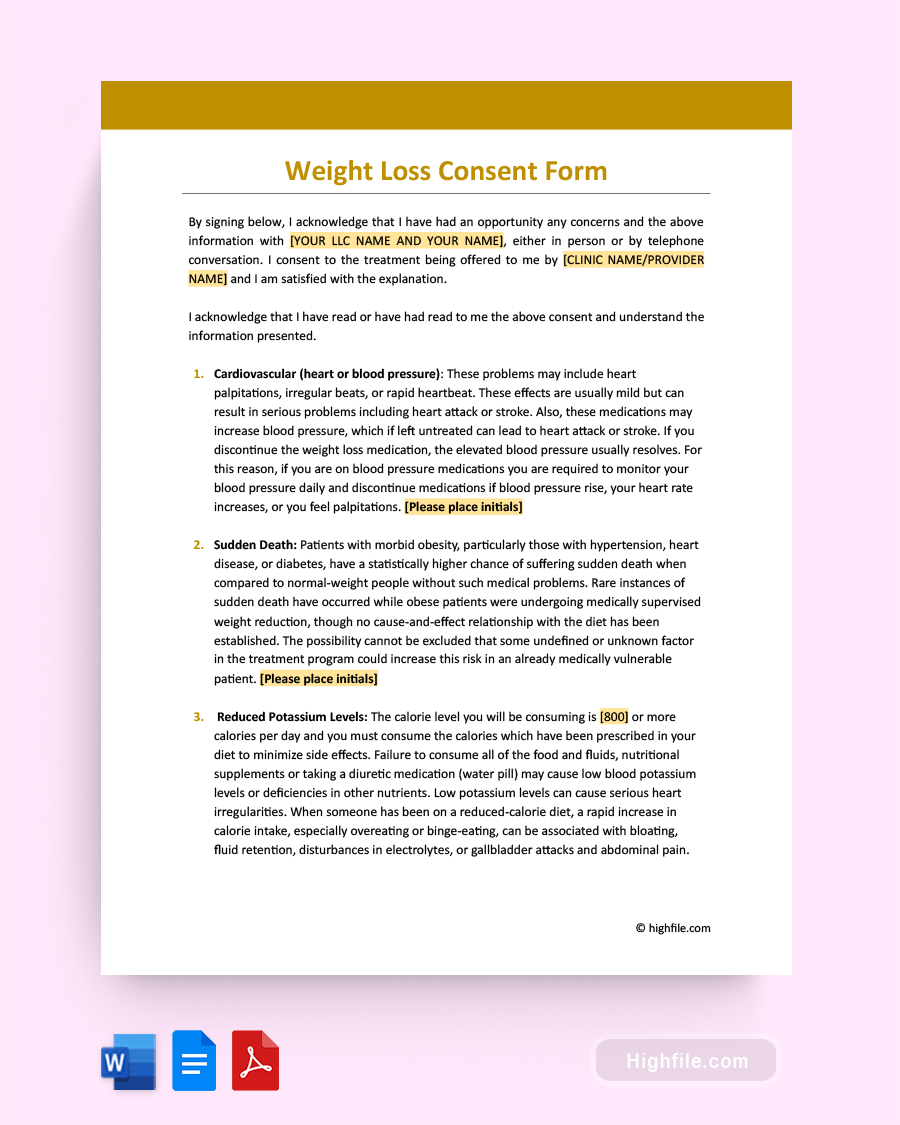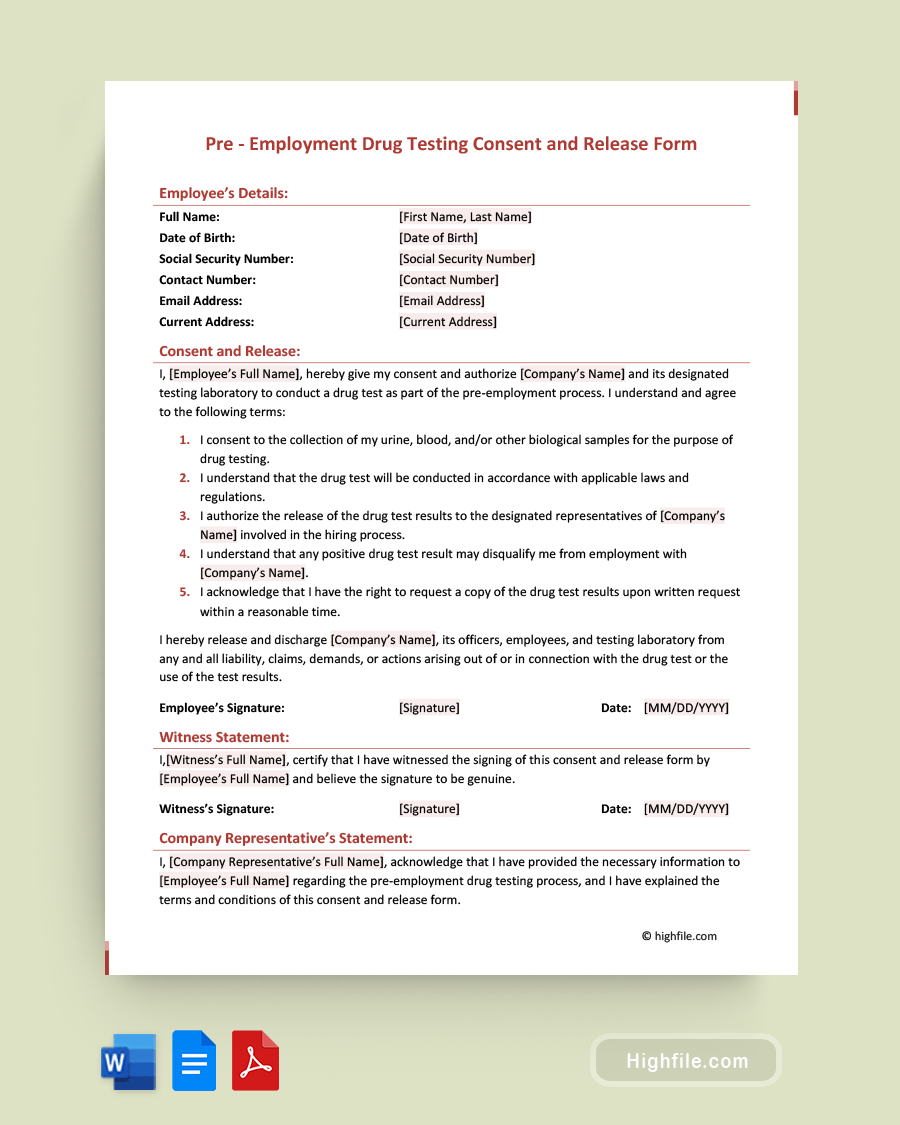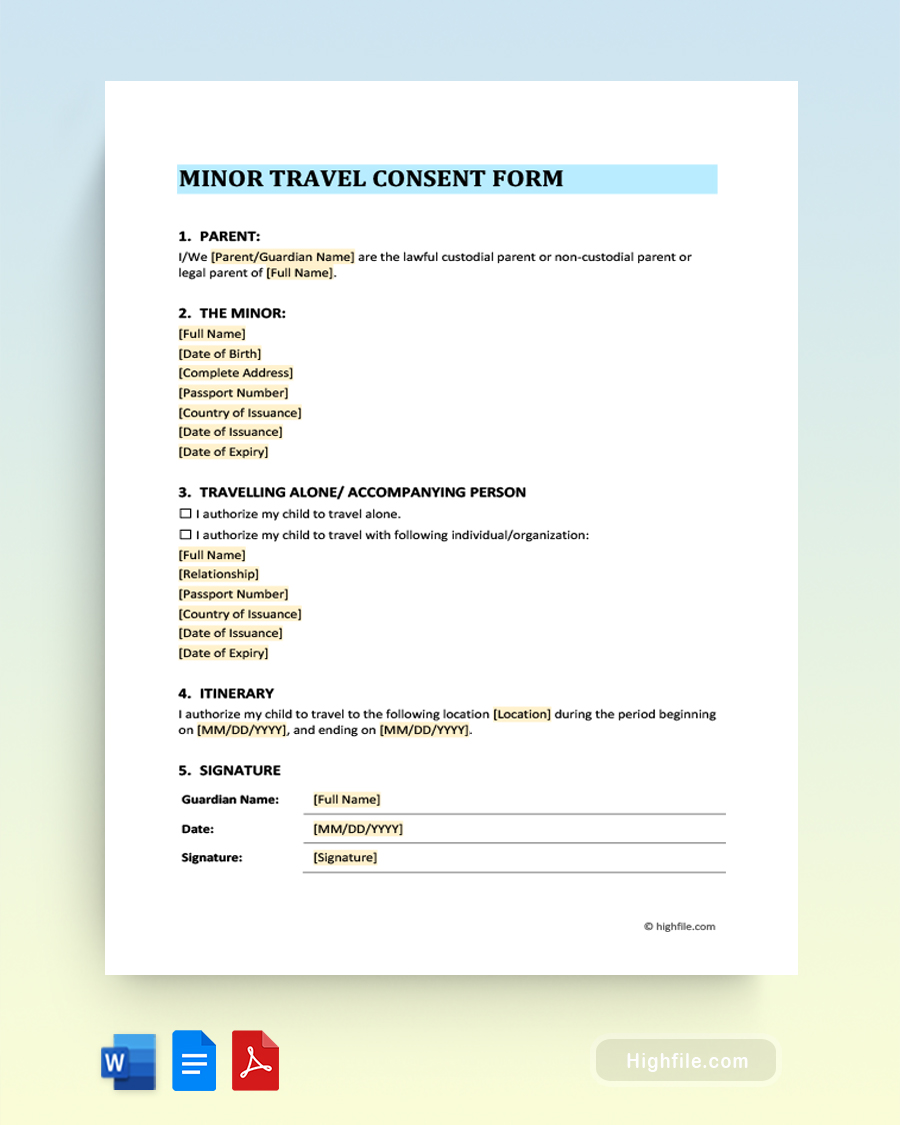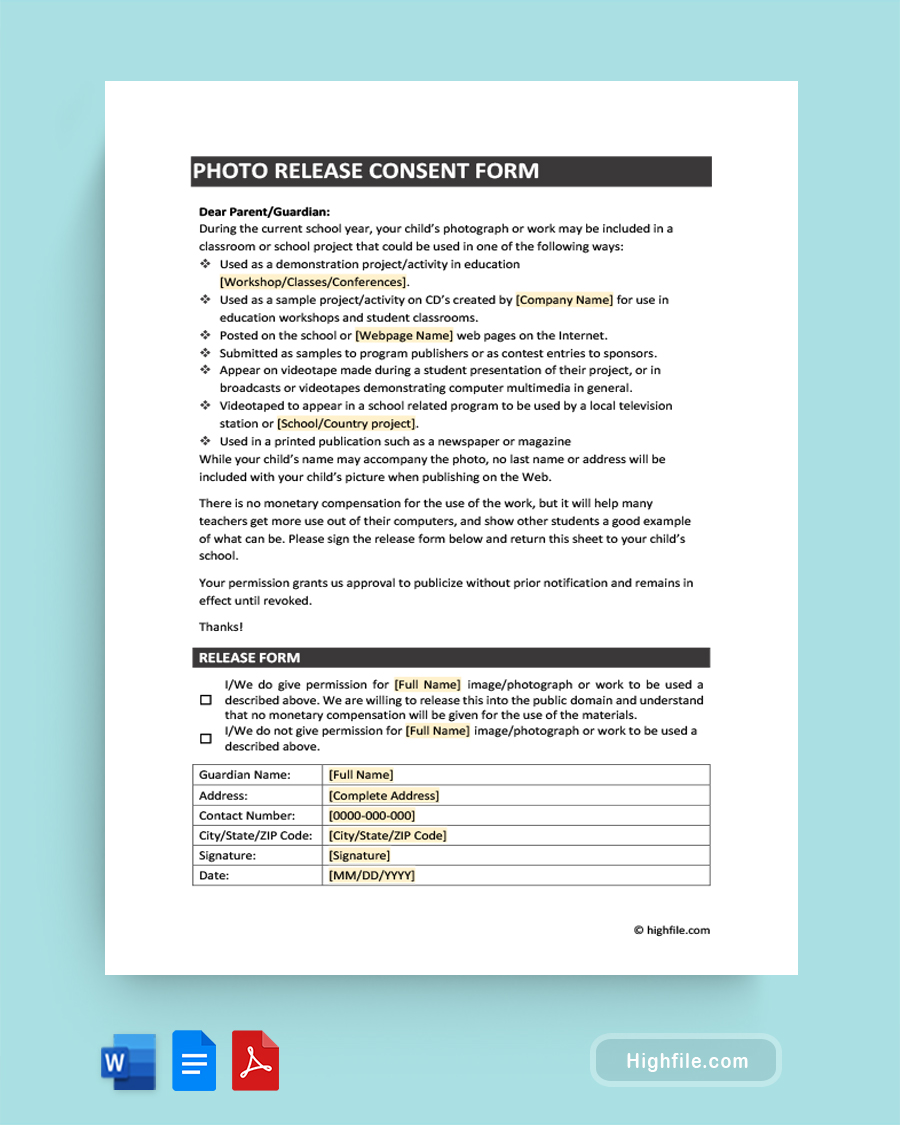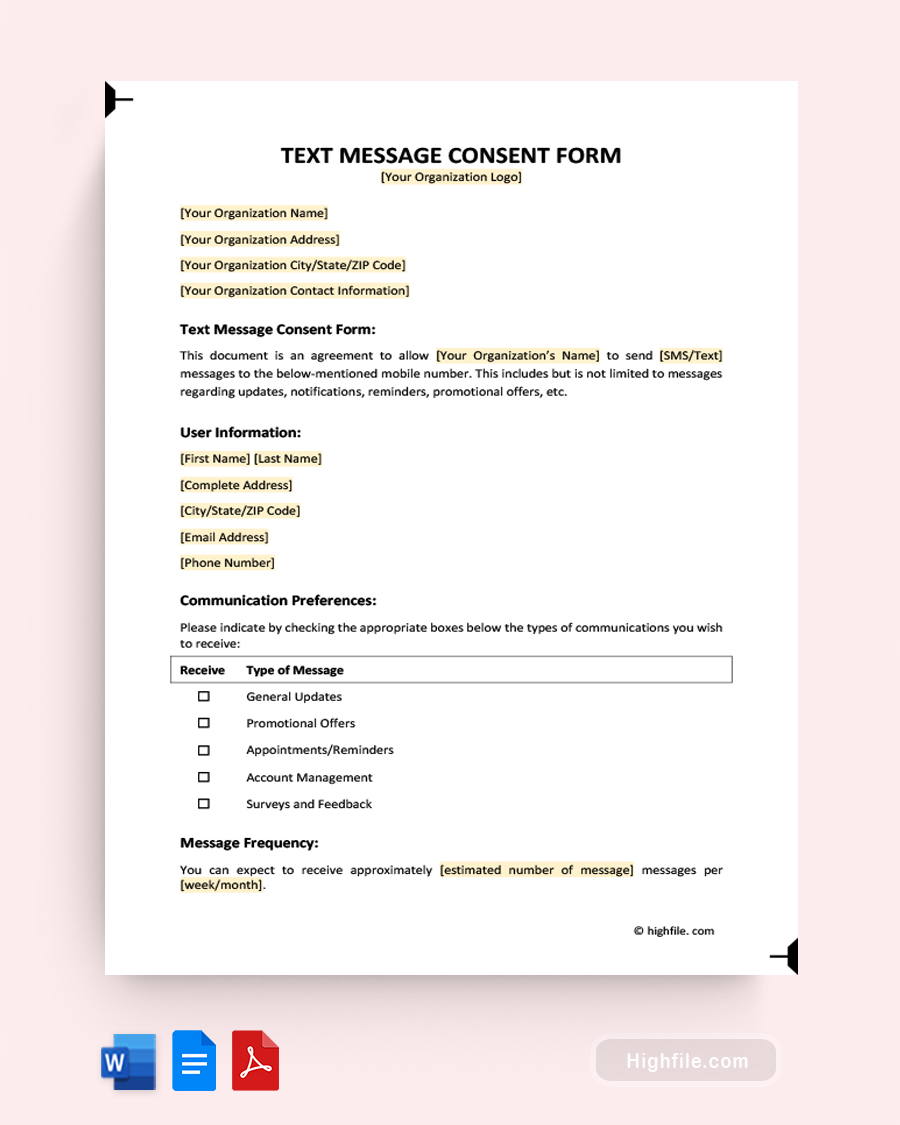Weight loss consent forms have been more common since the late 1900s when medical professionals began recognizing the potential risks of weight loss treatments. Around that time, many diets and diet programs began to focus more heavily on science-based evidence. However, the American Dietetic Association created the first known weight loss consent forms in the early 1900s. They were used to ensure patients knew the risks associated with various treatments and diets. While early weight loss consent forms typically contained very minimal information, their modern counterparts have become quite extensive as dietary science and understanding of the risks and potential complications have increased. We strongly recommend using our weight loss consent form template to ensure your forms include all the vital information needed to protect you and your clientele.
Since then, many other organizations and medical professionals have developed their own versions of weight loss consent forms. These forms often outline the potential risks associated with any weight loss treatment, as well as any alternatives that may be available. Additionally, these forms may contain information on how best to track progress toward the target weight and how to manage any weight regain effectively. Some versions of these forms provide an expiration date for patients to review their notes periodically. If a patient has lost a significant amount of weight, it is recommended that they consult their doctor at each review in order to maintain progress.
What Is a Weight Loss Consent Form?
A weight loss consent form is a document a patient signs before they start any medically overseen weight loss program or before receiving any treatment for weight loss, such as prescriptions or surgery. The form’s purpose is to ensure that the patient fully understands the risks and benefits associated with the program or treatment and to record written consent for the physician or healthcare provider to proceed with the treatment. Additionally, it helps respect patient rights and provides a liability waiver for medical professionals.
Why a Weight Loss Consent Form is Important
A weight loss consent form is an important document that outlines the risks and benefits of a medical weight loss program. It is used to ensure that the patient understands the potential risks and benefits associated with the program and that they are willing to accept them. The form also serves as a legal document that protects the patient and the provider from any potential liability.
For the patient, a Weight Loss Consent Form helps to ensure that their rights are respected and that they are aware of all the risks and benefits associated with the treatment. The form also helps ensure that their doctor follows all applicable laws and regulations. For the doctor, a Weight Loss Consent Form helps to ensure that the doctor is legally and ethically compliant.
Interesting Fact: Historically, weight loss and diets were primarily marketed as a fast fix and often used unsafe tactics to give rapid but temporary effects. Unfortunately, this often resulted in regaining weight or more and could have additional harmful effects on health. Fortunately, modern science and techniques have improved, and with them, our understanding of weight, health, and other relevant issues. There are now safer, more effective, and long-lasting treatments available. However, it’s essential to know that plenty of fad diets and scams are still out there. Always consult a medical professional to determine the best and safest course to reach your weight loss goals.
What Should be Included in the Weight Loss Consent Form
Knowing what should be included in the weight loss consent form is essential. The weight loss consent form contains information about the program, such as its risks and expected outcomes. It should also include information about the side effects associated with the program. It explains details of medical weight loss, such as the doctor’s right to determine caloric intake and the need for complete and accurate information. Additionally, it should show that the patient has discussed any questions or concerns with their healthcare provider and outline the benefits and alternatives. Below we’ve created a comprehensive overview of what information to include.
- Name and Logo- Including your business logo and name on the form is standard practice. Doing this helps create brand continuity and makes documents look professional.
- (Optional) Form Title- You do not have to list the title ‘Weight Loss Consent Form’ at the top, but some businesses choose to do so.
- Acknowledgments- Acknowledgment statements show the patient has read the form, knows the effect of signing, consents to treatment, and has had ample opportunity to discuss any questions or concerns.
- List Common Risks Statements- The risks should be outlined in detail, and patients should initial to indicate their understanding beside each one. Here is a non-exhaustive list of the conditions you may need to include and explain.
- Cardiovascular Health IssuesPsychiatric Health IssuesReduced PotassiumMedical Conditions Worsening (heart disease, hypertension, and glaucoma)Gallbladder DiseasePancreatitis
- Sudden Death
- Postmenopausal Women and Men Over 40 Addendum- This statement recommends that certain individuals have their cardiovascular health checked before beginning a weight loss program.
- Pregnant Women Addendum- Inform women that they must immediately inform their doctor and remove themselves from the program if they become pregnant, as weight loss is not generally considered safe at this time.
- Drug Interaction Statement- Remind patients that drug interactions are common and they must consult their prescribing doctor(s) before beginning a weight loss program.
- List of Common Side Effects- This list includes the most common side effects, reminds patients that these are rarely experienced, other side effects may be discussed during the evaluation, and indicates that most patients generally tolerate these minor inconveniences well. The list should include the most common symptoms, such as those listed here. Please tailor this section to your specific weight loss program.
- HeadachesFatigueLightheadednessAbdominal CrampingIncreased Insulin Sensitivity
- Nausea
- BMI and FDA Approvals Statement- Explain the BIM criteria for medical weight loss and medications. Include information about the increased risk in patients who do not meet these criteria and have them initial statements showing they understand that ‘off label’ and not ‘FDA approved’ use is allowed if they meet the following criteria:
- Effort- The patient has made efforts to change their weight through diet and exercise for the last 6 months without achieving those goalsEmotional Distress- This inability causes significant emotional distress
- Voluntary Consent and Waiver of Liability- The patient voluntarily consents to treatment and waives any liability for your (named) business and provider.
- Drug and Alcohol Prohibition- Patient acknowledges that they cannot drink or use drugs while on the program.
- Caloric Intake Limitation- This explains that the doctor will determine their caloric intake, and they will abide by that decision.
- Variability of Weight Loss and Acknowledgement of Inability to Ensure Efficacy- Inform the patient that weight loss varies from person to person and that you cannot guarantee their outcome.
- Agreement for Follow-up Visits- Have the patient initial an agreement to attend all visits, including follow-up appointments.
- Authorization for Evaluation and Bloodwork- Initialing here shows the patient consents to your intake process, including necessary bloodwork.
- Waiver- Have the patient initial, indicating that they have assessed the risks, consent to the treatment, and agree to waive liability.
- Understanding of Technique Limitations- This statement addresses the fact that not all treatments are FDA-approved or backed by significant scientific studies.
- Consent Statement- Restate that the client has had an opportunity to discuss their questions and concerns and that they are consenting to enter treatment.
- Name, Signature, and Date Lines- Have them print their name, sign and add the date here.
- Witness Name, Signature, and Date Lines- An outside witness does the same on this line.
- Risk, Benefit, and Alternative Acknowledgement- This separate section explains that the client accepts the risks and knows about the benefits and alternative options outlined below.
- Potential Benefits
- Decreased Disease Risks
- Psychological and Physical Wellbeing
- Alternative Option Acknowledgement
- Surgical InterventionMedicationsNon-Medical Weight Loss Programs
- Diet and Exercise
- Name, Signature, and Date Lines- The patient signs here again to show they have read and understood.
- Witness Name, Signature, and Date Lines- A witness to the process also signs here.
- Date- This is the date the form was completed.
FAQs
We’ve included answers to the most frequently asked questions about this topic below to help you create a better-quality weight loss consent form from your template. Here you’ll learn more about legal requirements, providing copies of signed documents to clients, who should sign, and other crucial facts.
You do not need a weight loss consent form template if you are just starting a new diet at home. A weight-loss consent form template is typically used for medical procedures such as weight-loss surgery and/or dietary programs involving prescription medication. It is important to remember that it is your responsibility to ensure that you are adequately informed about the risks and benefits of any diet or medical procedure before making a decision. It is best to consult with your doctor or healthcare provider before beginning any weight loss program or diet.
Both the patient and the witness should sign a weight loss consent form. The patient is the individual undergoing the weight loss procedure or program and is consenting to the terms and conditions of the agreement. The witness must be someone other than the patient, such as a family member, friend, or a different healthcare professional who is not the prescribing doctor. It is essential that the witness understands the risks and benefits of the program and can attest to the fact that the patient has been informed of these details. The witness’s signature is also a legal agreement verifying that the patient has informed consent for the program or treatment.
It is generally recommended that customized consent forms be used for weight loss programs rather than generic forms. Customized documents can be tailored to the program’s specific needs, ensuring that all relevant risks, benefits, and expectations are made clear to participants. Additionally, a customized form can help ensure legal compliance and any necessary liability protection. If you decide to create your own form, consult with a lawyer and the program director to guarantee that it adheres to the necessary requirements.
Yes, there are legal requirements for weight loss consent forms. These forms must be signed by both the patient and a witness in order to be legally binding. The document should include information about the risks and benefits of the weight loss program and any potential side effects. Additionally, the form should include a statement that the patient has been informed of their rights and responsibilities regarding their participation in the program or treatment. Finally, the document should include a clause stating that the patient has given informed consent to participate in the program.
Once a weight loss consent form has been signed, it is legally binding and cannot be changed. If you wish to make changes to the document, you must sign a new form that reflects the changes. The doctor will then enter that information into your medical record. Doing this ensures that all parties are aware of and agree to the changes that have been made. Additionally, you may need to provide a written cancellation document for the previous agreement since these forms are legally binding agreements between parties.
It is important to provide a copy of the weight loss consent form to the client. This form outlines the client’s rights and responsibilities when engaging in a weight loss program. It also provides information on the program’s goals, risks, and benefits. By providing a copy of the form, clients can review and understand the details of the program before committing to it. Additionally, this document can protect both parties by providing a clear understanding of expectations and responsibilities.
When a client has a medical condition or other health concern that may impact their ability to participate in the weight loss program, handling the situation with care and sensitivity is vital. The first step is to discuss the issue with the client and their doctor to determine if the program is safe for them to participate in. If it is determined that the program is unsafe for them, then it is crucial to provide alternative options tailored to their individual needs. It is also important to provide support and resources to help them manage their condition and reach their goals. Additionally, it is essential to ensure that the client understands any limitations associated with their condition.
Final Thoughts
Weight Loss Consent Forms are essential documents that help protect patients and doctors during weight loss treatment. The form outlines the risks and benefits of the treatment, as well as the patient’s rights and responsibilities. It also serves as a legal document that confirms that the patient has agreed to and understands the treatment plan. Using a Weight Loss Consent Form template can save time and help minimize human errors, creating a high-quality, easy-to-read, reusable, and customizable document.
